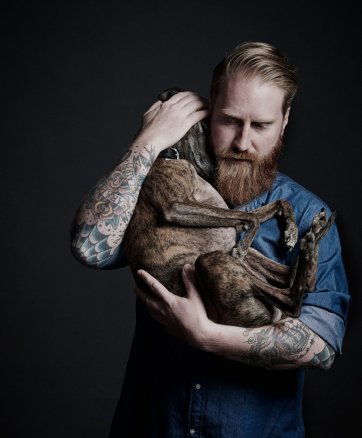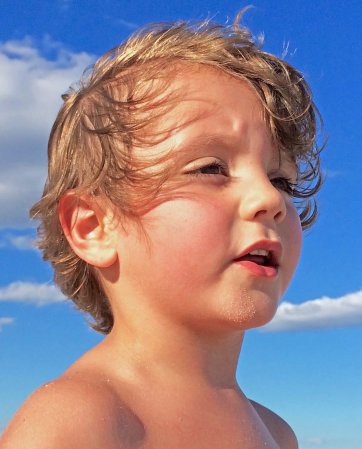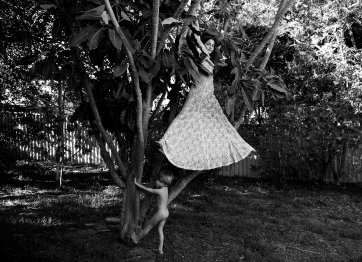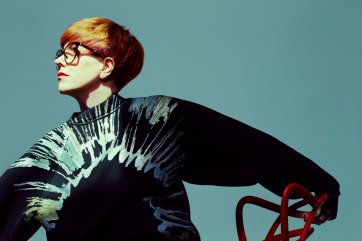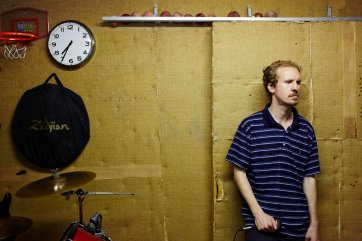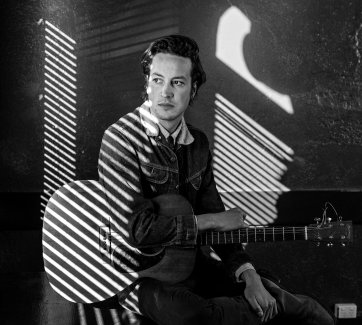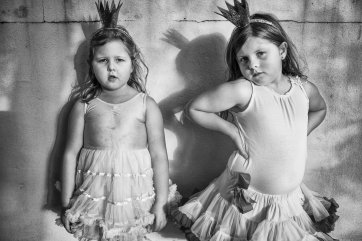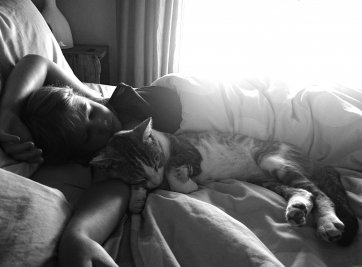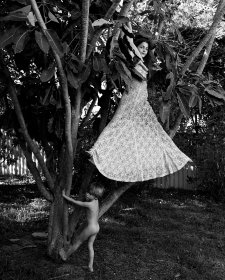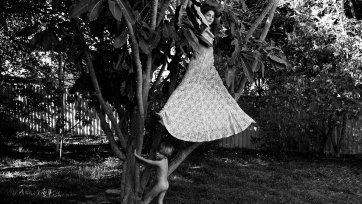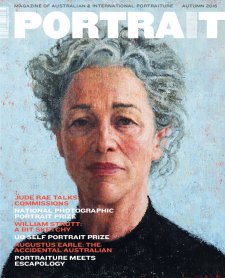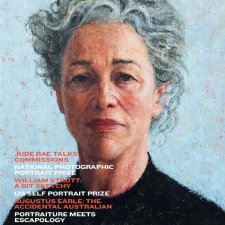The National Photographic Portrait Prize exhibition opens on 19 March, 2016 at the National Portrait Gallery. The show features forty-nine finalists selected from a total of approximately two thousand entries, with these most polished photographic gems extracted by a three-person judging panel comprising Christopher Chapman (National Portrait Gallery Senior Curator), Penelope Grist (National Portrait Gallery Assistant Curator) and Narelle Autio (Photographer). In the midst of their final deliberations in late 2015, National Portrait Gallery Director Angus Trumble sat down with the trio to discuss the methods and motivations behind the judging process, and to discover what, in the absence of flashbulbs, really makes a photo ‘pop’.
Angus: Thank you so much for agreeing to talk to me this afternoon. I wanted to begin by asking you about the process of boiling down essentially two thousand entries to fifty. How did you go about it? What’s the sequence?
Penny: We look at all the entries on a screen. The sequence is per the order they’re submitted: you see the sets; you see each photographer’s work together if they submit it all in one entry, which is sometimes quite interesting. Then we scroll through each one and, in the first run-through, if any of us says ‘maybe’, it goes into a ‘maybe’ pile. At the end of that process we had about 120. That took us all of yesterday. That was about seven hours worth of deliberation.
Angus: That’s interesting. So by that means you built up a Venn diagram of 'maybes’? Any one person’s ‘maybe’ made the cut – and from that you’ve got 125?
Penny: Yes.
Angus: Super. Were there any to which you said yes, yes, yes!?
Penny: There were some which elicited a much quicker response of ‘maybe’. There were some where we all just sat there quietly and nobody said anything, and we realised we were considering it deeply enough that it obviously triggered something for all of us. That went into the maybes. Then today – it was fantastic to be able to sleep on it because, Narelle, you were saying something quite interesting about the process of being so overwhelmed by the imagery yesterday?
Narelle: I think for anyone looking at 2,000 images – even people who look at photography – by the end it’s quite overwhelming. You’re not sure of what you’re judging in some respects. I guess that’s why we put them in the ‘maybes’; we were considering them and we didn’t want to kind of say ‘yes, definitely’ at that stage, because it was about looking at everything in the scheme of things. I think it was nice just to put them in a considered pile and then sleep on it, and then come back and look at that smaller group. It was really startling, actually, how much clearer we were the next morning.
Angus: That was today?
Narelle: That was today – there was not any sitting on the fence, very much. There were probably a couple at the end where we ‘ummed and aahhed’ a bit. Mostly we were fairly ‘cut and dried’ this morning. That was good.
Angus: I was part of the process last year and I remember it was 2400 or so entries. 2000 is similar, and large enough to get a sense of shared preoccupations. I remember last year it was pregnant women in natural environments who seemed to be on people’s minds. People with exotic birds, old people in bed – just distinctive aggregations of ideas. Were there any shared preoccupations this year that were similar? Or a whole new crop? I know, Christopher, you were part of the process last year?
Chris: There was a very ‘normal’ new thing of people with their pets; mainly cats and dogs. I reckon that probably constituted about half of the entries we received.
Angus: Wow.
Penny: The other half was the beach. Sometimes it was dogs and cats on the beach.
Angus: Is there an ongoing interest in babies in strange receptacles?
Penny: Not so many, no. Babies – definitely lots of babies, but few of them were in receptacles. There was one baby in a basket.
Angus: There you are; we call that ‘residue!’
Chris: The pets thing was a very notable one. Penny jokingly wondered whether we’d included in the terms and conditions that your entry must include a dog, because there was a huge number. Some of the best of those have made it through into the exhibition.
Angus: Wow. It’s interesting. Narelle – what do you bring to the process (as a practitioner) that might perhaps differ from your colleagues?
Narelle: I don’t know at this stage. I have to probably compare it to other years. I think in the end I said to them I’d be quite harsh, I think, because I’ve seen a lot of photography over the years and researched it myself. In the scope of what I do, I don’t like to repeat things that have gone before – I’m looking to tell a different story. I guess I’m looking for something that might affect me in a way that I haven’t seen before, or where I think ‘I wish I’d taken that picture.’ There’s also a bit of a technical element that I can bring, in terms of structuring a photograph, and where I think some lenses that were used are probably inappropriate to get the best of what they’re trying to shoot. Things like that.
Angus: Are we seeing more problematic Photoshop?
Narelle: There’s a lot of that. I’m a bit of a purist. It has to be for a reason, I guess. A lot of it is not for anything other than decorative reasons, and for me that doesn’t make a good photograph. There’s still got to be something brought to the pose; an opposition, or feeling that they’re giving. I think, sometimes, I’m more of a documentary-based photographer, so portraits that I do shoot, I kind of set them up and I find a beautiful light with a nice background and the composition; and then I like the wait for the sitter to bring something to the table, and give me something extra that I can actually capture as a photograph. It’s about capturing something that has never actually happened before; it’s that moment that we’re trying to bring forth, and I think you need to respect that the sitter should be part of that process. Otherwise it can be a painting. If you want to structure it completely how you want, you might as well paint it. I think there’s a collaboration that always goes on with photography that’s important for my process.
Chris: It’s an interesting issue, isn’t it, because Photoshop is merely the retouching of our time. Various processes of modification have always existed.
Narelle: I think Photoshop is very valid. I’ve grown up in the darkroom era, where we burn and dodge, and you alter a photograph quite a lot in a darkroom and I think you should be able to do that digitally. You can still burn and dodge and re-create a mood. Too much retouching – you can take photographs too far, and I think the decorative thing of overlaying things on top of something – it’s just not for me. I think it’s good for iPhone and your Facebook posts and stuff.
Angus: Were there any instances of entries that were quite obviously shot with an iPhone?
Narelle: Yes. It’s really interesting how quickly our brains process the eyes in a ‘selfie’. Very often we would just be able to see, from the person’s eyes, that it was a selfie, even though it may not be obvious from anything else in the photograph. It was really quite startling; I didn’t expect to be able to see it quite to that extent.
Penny: There’s that lack of interaction, almost; it’s different when you shoot, I think, with the camera further away, because there is marked interaction. When you’re looking at something really close up, it’s vacant. There’s nothing happening behind the eyes.
Angus: You’ve boiled it down now to fifty-one. Upon reflection, do you think there’s a sort of body or shape to the selection such that people visiting the show will say ‘Aha, this group of judges has reached a particular kind of consensus’?
Chris: It’s a very uplifting group of images; and it’s quite a diverse stylistic mix and quite a diverse group of sitters, young and old. If anything, perhaps more so than some previous years, it’s marked by that eclecticism, I think. We haven’t ever ... we certainly didn’t set out with any aims in mind.
Narelle: No preconceived kind of ideas.
Chris: No. We were coming down to that final, approaching fifty, which is our ideal number logistically. Again, it seemed to make sense that, as the number went down, some of the images didn’t stand up in their company, if you like. We swept through all of our short-list and the entire group again to check that we hadn’t overlooked anything. We’re pretty happy with the end results as holding together; I don’t think it reflects a particular tendency in portrait photography, but there’s a sense of positive outlook that infuses pretty much all the images in the show.
Would you agree?
Narelle: It’s interesting how that’s come out.
Angus: Just taking your thoughts one by one as individuals, I’m interested about yesterday as opposed to today. Today seems to be coming together with a consensus. Yesterday was separately bringing different sets of criteria, possibly, to the process. What do you [Penny] think you bring to the process that differs somewhat from Christopher and Narelle?
Penny: Strangely, because I’ve been working with this movie portraiture project, I’ve been sifting through thousands of images from the span of film history, from publicity portraits to films stills, mainly. I think I found myself being very struck by styles that were either narrative or, in some ways, glamorous. That was very clear when we came through today; I think there were ones where I was a ‘yes’ and
my colleagues were probably ‘no’. I realised, because it looks like something from the 40s, that I’ve gone there. Some of the ones that had that really strong narrative element came through as well, for all three of us.
Angus: Chris – so you’ve been a judge several times?
Chris: Yes – I think what I always look for is a sense of self communicated very clearly; that we’re being given some idea of the uniqueness of the person in the photo. This year in particular I was paying a lot of attention to the formal make-up of the image itself: it’s integrity, visually. That’s something that we all talked about with some images – that it perhaps reflects a sense of skill that a photographer has. It’s one thing to grab an arresting image that is a fleeting moment in time. It’s another to be able to do that and also have that image held in some sort of balance; not necessarily symmetrical balance, of course. When the combination of those two things comes together– a compelling subject and a very strongly constructed image – I think it’s fair to say those images stood out; I was paying a lot of attention to that.
Narelle: I think we were quite tough on works that were almost there, but not quite. Just going back to what was said about an ‘eclectic’ kind of group: it’s quite possible that, because I don’t work as a portrait photographer, I guess I might be a little bit more open to an entire scope of portrait photographer. I don’t work in it; I’m not thinking or trying to replicate what I do in a conscious way. That might contribute to that eclecticism.
Angus: It raises the question, doesn’t it? Did you sense from this crop a sharp distinction between people who were, in fact, strategically trying to meet a portrait requirement, from those who were submitting an image that happened to be of a person that would fit neatly or approximately within the criteria? A deliberate attempt to address the genre, as opposed to taking advantage of circumstance?
Narelle: I think there definitely were a lot that we were conscious of, in a certain way. I was kind of looking for ‘the recipe’. We were quite hard on them; we weren’t excluding them but we said, okay, if you go that way they’ve got to be perfect.
Chris: That’s right – certain sub-genres that you see involving, for example, nature, a weathered face; when we were considering those sorts of images they had to really do it very well because they have become clichéd in many ways.
Angus: Now what lies ahead is the show, and at that point you will chose a winner. Do you have any sense at this point of any front-runners, or have you deliberately withheld that judgement?
Narelle: I think there’s a few that are really clearly amazing and strong images. We will definitely wait and see what they look like in print form before we make the final decision.
Chris: There are a number of pictures in this year’s show that we really think are pretty sweet.
Penny: Not one, at the moment. I’m definitely leaving it open because I want to see the images; there are probably at least half a dozen that are up there.
Angus: It sounds like you, as a unique threesome, found it relatively easy to arrive at a consensus?
Narelle: Surprisingly easy. Especially to get it down to the 120, and then it was quite clear this morning. There were a few long, considered discussions!
Chris: I’ve done a bit of this lately and the favourite question that people ask you at the show is you must have found it so difficult. Actually, I confess, I usually find it pretty easy! Especially when you’re functioning as a group to form a consensus, and not as a single judge; I think it actually makes the task easier if you have sounding boards.
Penny: Absolutely.
Narelle: I think that’s fair. I think it forces you to be reflective. I’ve never done this before, ever.
Angus: This is the first time for you, Narelle?
Narelle: Yeah. I was quite worried about what I was reacting to in the portrait; whether it was a personal bias, and wasn’t a response either to the portrait or the quality of the photograph. It’s very useful to be able to talk that through with the other judges. I think I would have found it much more difficult by myself for that reason. It’s good to be able to talk through ‘why’.
Penny: I think that lesson of ‘more eyes on it brings clarity’ is also one that can be applied more generally, including submitting the photographs. The photographic milieu often involves working in isolation, so really it’s a lesson to have someone else look at it first. As many people as you can. That will just enable you to be stronger.
Angus: Entrants submit their work, but they also submit a statement; is that correct? Did you find you were taking account of the statement or deliberately holding off?
Narelle: The first day we read almost none of the statements, and today we read most of them.
Chris: In fact, we didn’t read any statements; we didn’t read any information about who the photographer is and who the subject is. In some cases we were able to recognise either of the two, but it wasn’t until we had our shortlist that we looked at the statements. And that was really to get that extra layer of information at that point, once we’d already evaluated the image on its merits.
Angus: Is there anything else you’d like, individually, to say about the process, upon reflection? Narelle? Anything surprise you? Shock you? Delight you, or ... ?
Narelle: I guess it was really a nice surprise to find it’s such an egalitarian competition, because there are lots of amateurs and people who may not necessarily have even shot many pictures, but just happen to get a great picture; they are in the contest among everyone else. As a photographer it’s always interesting to see what other photographers are doing, and how they’re accomplishing it and what direction they’re taking.
Angus: Great. It goes back to that point about 2,000 being an ample number to reflect that whole national scope, so it’s looking at a snapshot of a whole national practice. More than adequate, and I think most statistical cohorts for opinion polls are not nearly that large. 600 is ample, and that’s to ascertain the opinions of the country. Christopher?
Chris: I find it quite fascinating that every time I've been involved it's very clear that the final forty or fifty stand well above the rest; there’s that similar compelling number, irrespective of the number of entries. We've talked about that on this occasion, so that's an interesting recurring statistic, I think.
Angus: Even at the ‘lower’ end of the fifty-one, there’s still a standard of excellence that is beyond dispute. There aren’t too many limping antelopes at the edge of the herd, is what I’m saying.
Narelle: There are some really simple pictures in there, but we thought that they were executed pretty much perfectly. I think it shows you don’t have to trick it up.
Penny: The thing I was really struck by relates to the whole gamut of the photographs submitted; not the ones that made it through or weren’t perfect, beautiful photographs or really worked up portraits, but the overwhelming sense in aggregate. It’s something that was mentioned during the judging: the sense that they’re photographing, most of the time, the most important people in their lives. It’s a lot of kids, it’s a lot of families, it’s a lot of love, really. It’s an extraordinary portrait of the affection that people have for each other, and how Australians experience and show that. I think that probably does come across in the final selection too, but it was really striking, interesting thing for me, going through them all.
Angus: Thank you very much.
The above is an edited version of Angus’ interview with the National Photographic Portrait Prize judges. The Portrait editorial team have independently selected a range of finalists to accompany these words - this is no way reflects any judges’ decisions concerning winning entries.

